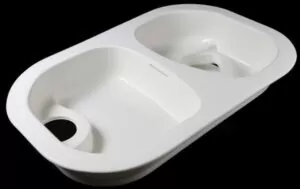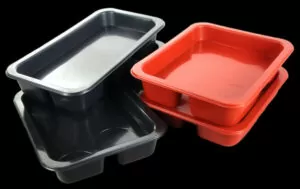In today’s technology-dominated world, it’s easy to overlook how much we rely on something as basic as electronic enclosures. This simple protective measure against natural factors or mechanical support systems brings great convenience to our lives. The vacuum forming behind the casings of these electronic products is also worthy of attention. When manufacturing backbone products such as electronic product casings, vacuum forming may be used more frequently than people think – this process provides both customization capabilities and these industries critical side efficiency.
Manufacturing, especially electronics manufacturing, requires a combination of accuracy, efficiency and creativity. Producing robust and complex housings for electronic parts isn’t easy – they also need to be cheap! Compared to injection molding or other methods, vacuum forming stands out because it allows us to create custom cases quickly and without any mistakes. This article takes an in-depth look at vacuum forming technology: readers will learn everything there is to know about how it works and why its use has become indispensable in this field.

Understanding Thermoforming in Detail
The core of the thermoforming process is to heat the plastic sheet, then adsorb it to the mold and wait for it to cool before forming. Thermoforming is further divided into three distinct processes:
Roll Fed – the plastic sheet is fed from a roll into the oven.
Sheet Fed – individual sheets are loaded into the machine.
Both of these methods involve the plastic being heated and then pressed into a mold to create the desired form.

In addition, the heavy-gauge thermoforming process deals with thick plastic sheets, typically for larger parts, while the thin gauge thermoforming process manages thinner sheets and usually results in packaging or smaller parts.
There are several thermoforming methods used in actual production: differential pressure molding, cover molding, plunger-assisted molding, suction back molding, opposite mold molding, female mold and male mold thermoforming, thin gauge thermoforming, heavy gauge(thick gauge) vacuum forming and twin sheet forming.
Thermoforming in Electronics Manufacturing
Thermoforming process is a versatile manufacturing process that can create detailed components from heated plastic sheet. It is used for both small and large parts, with applications ranging from consumer electronics,medical devices to industrial control systems – specifically their enclosures. Unlike other methods, thermoforming easily produces custom shapes such as undercuts or internal features like lugs (which grip onto things) at little extra cost because its moulds are inexpensive too!
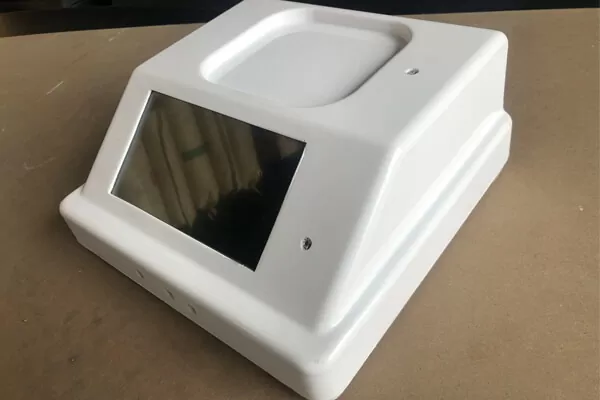
Why Thermoforming for Electronic Housings?
The decision to use thermoforming for electronic housings is multifaceted. Cost, speed, and design flexibility are the main drivers behind this choice.
Cost-Effective Production
Thermoforming is typically used in medium- to large-scale production and is a low-cost alternative to injection molding or other traditional methods when budgets are tight. Thermoforming molds cost less than injection molds, which makes thermoforming attractive for companies looking to reduce initial expenses.
Thermoforming generally has lower-cost molds than injection molding and 3D printing because it can use cheaper mold materials. Additionally, being able to make multiple parts simultaneously reduces labor – when manufacturers save money like this, those cost savings are then passed on to consumers, making devices more affordable and easier to use.

Quick Turnaround
In the rapidly evolving electronics industry, rapid development of prototypes and products to market can make the difference between success and failure – and that’s exactly what thermoforming technology excels at. With low-cost tooling and short delivery times, it allows companies to stay one step ahead.
Design Freedom
The design flexibility provided by thermoforming allows the housing to incorporate multiple features such as snap-fits, standoffs and other custom elements to improve component positioning and user interaction. The technology also helps keep wall thickness consistent to maintain the overall strength of the part.
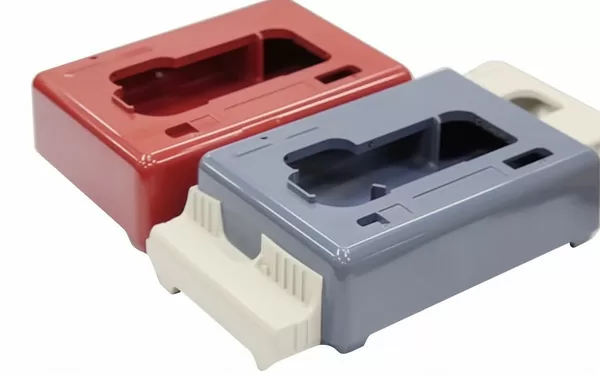
Thermoforming opens up a world of design opportunities. It can be deep drawn, making it ideal for electronic housings and covers that need to fit into complex shapes. With the right tools or manipulations, you can also add textures, undercuts, and other features – meaning you’re not limited in terms of geometry. This is especially exciting for consumer electronics: because now their protective gear must not only be functional (although ours definitely is!) but also look cool. This means that the final product not only protects the overall user experience, but also becomes a part of the overall user experience through custom colors, logos and finishes.
Efficient Prototyping
Prototype production can be carried out efficiently using thermoforming. Molds are cheap and easy to make, so low-volume production is not expensive. This is very important when you are designing a new electronic device and may need to make changes after making a few prototypes. With thermoforming, the time between modifications is short – meaning your design can be perfected quickly without much upfront investment!
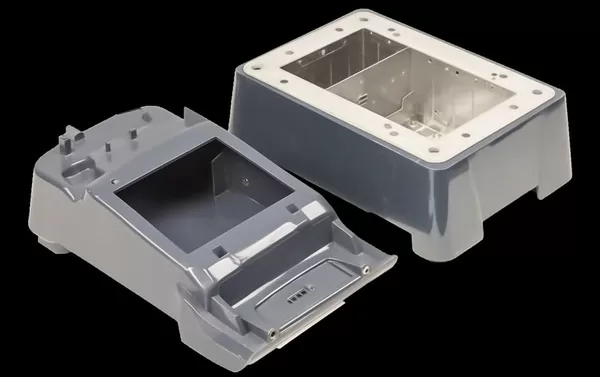
Material Selection
One of the main advantages of thermoforming is its ability to be used with a variety of materials. Whether the designer needs a rugged enclosure that can withstand high impact, such as one made of ABS, or a clear plastic to enclose a transparent component such as a polycarbonate plastic sheets; there are plenty of options here too! This versatility means that the enclosure is able to meet not only physical protection requirements, but also additional needs such as wireless signal permeability/thermal management needs – which can be critical if electronics-intensive products are to be commercially successful.
Thermoforming for Electronic Housings: Key Considerations
Although thermoforming has advantages in many aspects, it is not a panacea. There are several important factors to consider in determining whether it is suitable for electronic enclosure production needs:
1. Material Selection
Material selection is critical to both the success of thermoforming and the functionality of the final product. High-impact polystyrene (HIPS) and acrylonitrile butadiene styrene (ABS) are common choices when producing electronic enclosures, both known for their ease of use and heat/impact resistance.
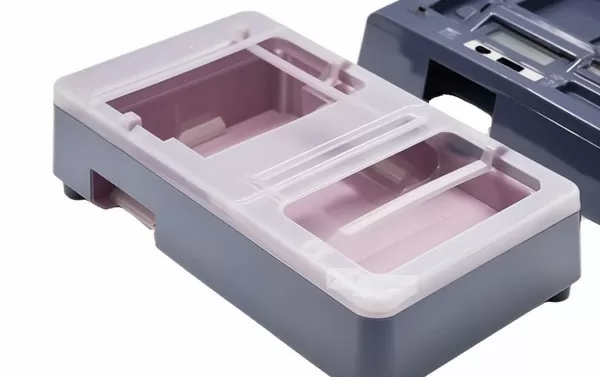
2. ESD and EMC Considerations
In applications where sensitive or precision electronic equipment is used, it is important that the housing material provides protection against electrostatic discharge (ESD) and electromagnetic interference (EMI). Thermoformed shells can be made from materials specifically designed to address these issues, meaning anything they surround remains secure and works as expected.
3. Surface Finishing
The surface finish of the case is crucial when it comes to user experience and branding. Thermoforming can produce textured (such as wood grain) or smooth finishes – although sometimes further steps such as painting or coating may be needed to get the look you want.
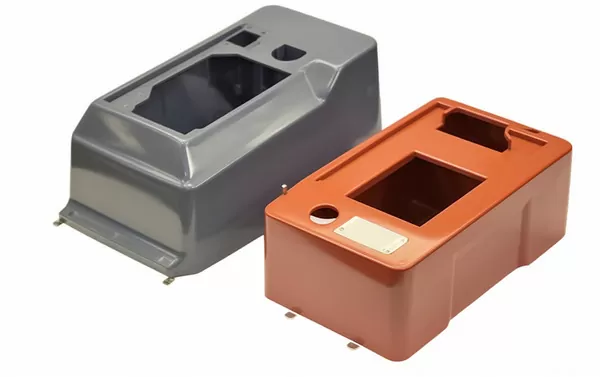
The Integration of Thermoforming with Modern Electronic Devices
1. IoT and Smart Home Applications
As smart home devices and the Internet of Things grow, so does the need for sophisticated electronic enclosures customized to individual needs. These products that interact with the home environment often must be shaped to blend seamlessly with the interior design. Thermoforming offers a solution: it allows the housing to not only fit the appliance perfectly, but also look great, playing a crucial role in consumer acceptance and aesthetic appeal.
2. Wearable and Portable Devices
Housing design for portable electronics and wearable devices is particularly challenging because they must be small and light. Thermoforming can create a case that is both lightweight and strong, which is crucial for fitness trackers or devices implanted in the body.
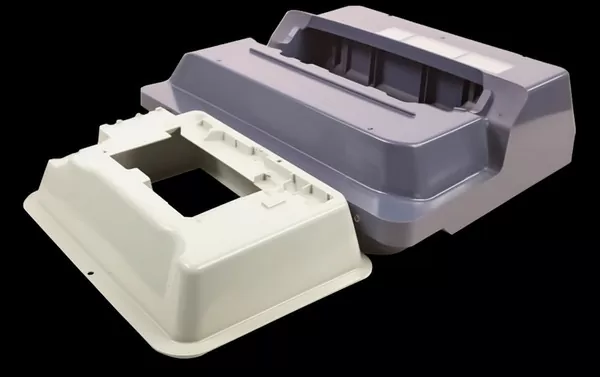
3. Industrial and Other Specialized Electronics
When it comes to industrial electronics, nothing beats the ruggedness provided by thermoformed enclosures. These devices often operate in harsh conditions, and their enclosures (or enclosures) must be resistant to moisture, chemicals, and extreme temperatures. Thermoforming offers materials selected precisely for those properties, plus more options if needed, so no matter what environment awaits, each shell is up to the task!
Case Studies in Thermoformed Electronic Housings
To truly appreciate the impact of thermoforming in electronic housing manufacturing, it’s useful to look at some real-world examples.
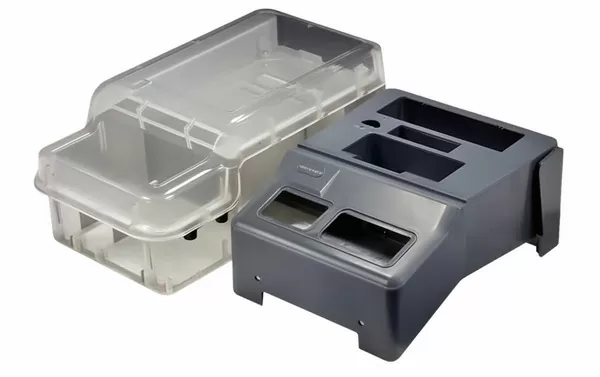
Handheld Devices
Thermoforming plays a vital role in the manufacture of lightweight and ergonomic housings for portable electronic devices. It provides protection for delicate inner workings.
Control Panels
When it comes to industrial control systems, pressure forming allows designers to create housings with precise apertures for displays or buttons, ensuring users get an interface they find easy to use and long-lasting!
Larger Enclosures
Thermoforming also does allow for the production of larger containers. This process not only makes them strong enough so their shape doesn’t change easily, but also uniform throughout the entire wall, which is invaluable for maintaining structural integrity.
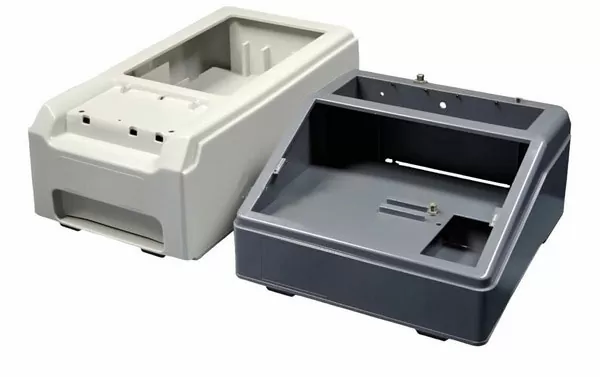
Future Trends and Innovations in Thermoforming for Electronics
The future of thermoforming in electronic housings manufacturing is bright, with several trends pointing to continued growth and innovation.
3D Printing and Mold
Recent advances in 3D printing technology are changing the production of thermoforming molds. Through additive manufacturing, it is now possible to quickly and cheaply create molds with complex designs – including those required for electronic enclosures that are themselves becoming increasingly complex.

Smart Materials
The development of smart or functional materials may soon enable manufacturers to provide not only protection and beauty, but also self-healing capabilities (if the casing is damaged), color changes and even indicators for enclosed electronic devices, providing something beyond protection and beauty. new function.
Sustainable Practices
Sustainability is a key area of increasing concern in many aspects of today’s electronics industry activities. Therefore, it appears that additional environmental brownie points could be gained through wider adoption of thermoformed forms and increased use/recycling of such polymers, as well as cost savings elsewhere.
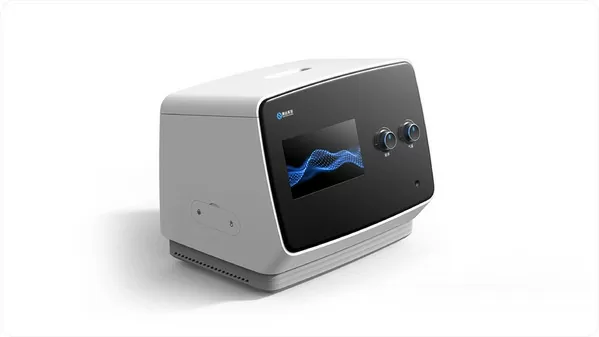
Sustainability is increasingly important for plastics – and thermoforming is no exception. Today there are many ways you can recycle more materials; use biodegradable polymers where possible; and even find new heating technologies that save energy and still meet all the requirements required by e-housing standards!
Digital Manufacturing
Digital manufacturing is transforming thermoforming and other industrial processes. Artificial intelligence systems use machine learning to increase efficiency, reduce waste, and even predict problems that could bring production lines to a halt. Automation brings further benefits through increased precision and speed – all of which help meet today’s growing demand for goods such as food packaging or car interiors.
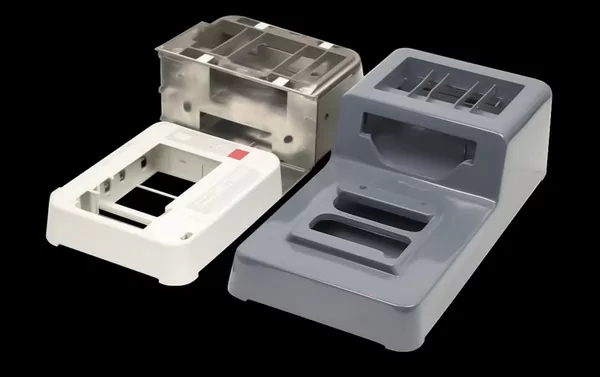
Advanced Surface Treatments
Surface treatments such as painting, textured mirroring, or metallization have multiple benefits for thermoformed parts. In addition to making them look great, treatment can also increase the conductivity of electronics.
The Competitive Edge of Thermoforming
In summary, thermoforming is an important process for electronics manufacturers to consider in order to save money and time while also being able to make design changes easily. By leveraging these advantages, companies can create well-performing and stylish cases at a lower cost than other methods. As technology continues to evolve, there will surely be greater uses.
So if you want to stay competitive, it’s worth learning more about how thermoforming works! It doesn’t matter if someone makes a lot of one-off luxury electrical goods: the technology can make something at any scale available to everyone involved in electronics production.
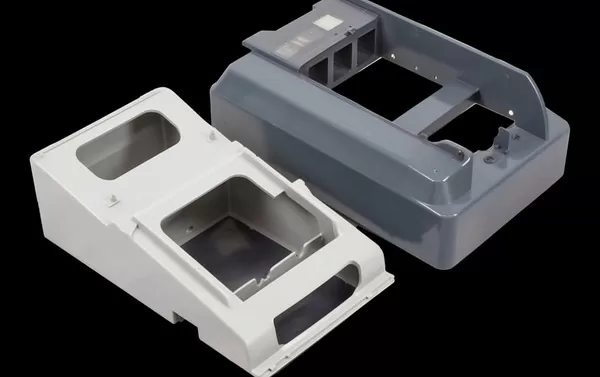
Industry Challenges and Future Outlook
1. Material Innovation
An important goal is to create new materials for thermoforming that are more advanced and tailor-made. This means they need to be lighter yet stronger to withstand the wide range of uses found in today’s electronics market, especially those with an increasing number of applications. For example, successful integration of nanomaterials has the potential to significantly improve the quality of thermoformed housings.
2. Scalability and Globalization
Since electronics are sold globally, it is critical for companies that provide thermoforming services (or capabilities) to have factories (or at least scalable factories) in different regions. However, a manufacturer of this size faces huge challenges; not only around standardizing processes, but also ensuring that the level of quality control does not vary between continents!
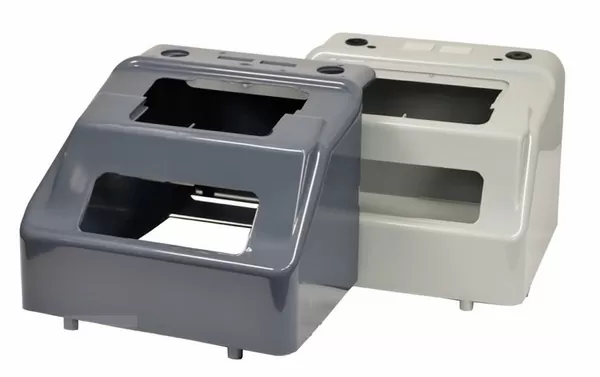
3. Regulations and Standards
If you want your customers to trust your brand enough to buy from them again the next time the need arises, meeting strict regulations on material use and what happens to your product once it enters a specific country/market is also non-negotiable… Thermoformers Innovation must continue while keeping costs down and still fully comply with the individual rulesets that govern everything, such as labeling requirements, plastic recycling targets, etc.

Conclusion
The role of thermoforming, particularly through the matched mold forming process and industrial thermoforming equipment, is pivotal in the manufacturing of electronic housings. Thermoforming plays a vital role in the electronics industry, not only as a manufacturing technology but also for its ability to provide multi-faceted, customized housings for a range of devices at affordable prices. As our world becomes increasingly reliant on electronics across a variety of industries, thermoforming has become even more important in protecting technology and helping to advance innovation. With ever-evolving technology and a greater emphasis on sustainability than ever before, get ready for thermoforming to maintain its leadership in electronic enclosure manufacturing – and there are exciting new developments coming, too!



